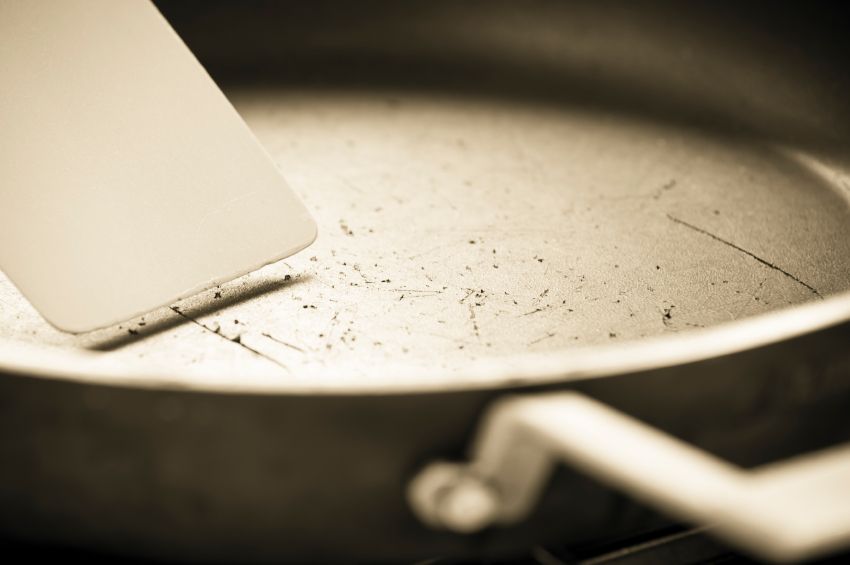Wondering what are the best skillets or frying and sauté pans on the market? For professional chefs, various factors like heat conduction, weight, durability and reactivity must be taken into account prior to purchase (which often happens by the dozen). So what are the options out there on the market and at specialty chef’s shops?
Well, talk about high-quality cookware to nearly anyone who knows their way around a kitchen and chances are you’ll hear about All-Clad. Yes indeed, All-Clad is a fantastic name brand for pots, skillets, frying pans, and sauce and sauté pans. But, if you can imagine actually having to sauté on the line for eight hours, the weight of the pan definitely add some strain to the arm and wrist. What undoubtedly makes the brand a winner is its balanced heat conductivity, meaning it will evenly distribute the heat throughout the pan, making for an even cooking temperature. Furthermore, because it’s stainless steel, it’s non-reactive. This means if you’re cooking anything that is acidic like tomatoes or, believe it or not, corn, squash, grains and many legumes or if you’re cooking with cooking wine, vinegar or some other acidic liquid, the metals in “reactive” pans will react with what’s in the pan and impart a metallic taste in the food and usually stain the pan. 100% stainless steel pans do not have any such problem. For this reason, they’re a solid choice for any pan that will be used for sauté, sauce-making or for cooking of foods with a high acid content. Other popular (some are more affordable too) makers of heavy and heavy-duty tri-ply stainless include Calphalon, Cuisinart, Sur la Table and Vollrath. Tramontina is another notable manufacturer of affordable stainless steel with pans made of 18/10 stainless steel, aluminum core and magnetic stainless steel. Check out various reviews online prior to purchase and be sure to check to see that the brand you’re buying really does have balanced heat conductivity. Some claim to but upon scouring the reviews, that claim can be called into question.
Now, returning to the problem of weight, All-Clad has come out with a slightly lighter Master Chef 2 line. A non-stick fry pan made of 3-ply bonded construction consists of a brushed aluminum exterior, a pure aluminum core for even heat distribution, and a layer of durable, scratch-resistant nonstick. The nonstick coating available on the sauté and fry pans is perhaps the biggest point of contention for chefs, with some calling it a godsend, others a liability since non-stick cannot be used with metal spatulas and in most pro-kitchens this is sure to happen anyway. Then, there’s the concern of Teflon or non-stick surface material peeling off and ending up in the food. Other pans in the Master Chef 2 line are composed of brushed aluminum exterior, 100% aluminum core which extends up the sides of the pots and pans to give balanced heat-conductivity prevent hotspots. Common complaints are a drop in the quality of workmanship and yes, some chefs do not like the lighter weight, estimated at 25% less than All-Clad 100% stainless steel.
Carlisle makes a number of permanently bonded aluminum pans with stainless steel interiors. This brand is popular with many chefs. Stainless steel interiors provide a non-reactive cooking surface. Carlisle seems in-touch with the demands of professional chefs; their website lists the dimensions and weight of each pot and pan they manufacture (averaging 16-17 lbs.) and assures that their cookware will not react with food or have hotspots and scorching.
Sitram is another notable more affordable line which carries copper bottom stockpots and pans which are used by many professional cooks and chefs. Many claim the copper bottom cookware is dishwasher safe, though a visit to their website could not confirm nor deny that claim. Copper bottom has long been synonymous with achieving an even, balanced cooking surface, however there are claims that the copper bottom does not extend far enough to the edges of the pans to ensure even temperature throughout. As a result, it is possible one may experience hot-spots with this product though the reviews are very mixed. On the lightweight front, the Frieling Sitram (the U.S.A division of the French company) offers aluminum core sauciers and pots with stainless steel external shell throughout.
But perhaps it’s back to the past where we must go to find a fry pan that is lighter in weight. Light Cast Iron Frying Pans are gaining recognition amongst the chefs. The same traditional cast iron of yesteryear is used in these pans but the thickness is just 50% of the pans of yore. They heat quickly, require little to no oil and are great for browning and adding flavor to vegetables and sauces. Alas, cast iron is reactive, so attention to what you’re cooking and yes, a stainless steel saucier pot is, it seems, inevitable.
Last but not least, anodized aluminum is apparently 100% non-reactive and is an excellent conductor of heat and, thanks to its light weight it’s very easy on the wrist. Technically, hard anodized aluminum acts as its own conductor of heat, hence as the pan is introduced to a flame or heating element, the heat travels up through the sides of the skillet or sauté pan or saucier making it a good choice for more delicate sauces. Now is there consensus on this lightweight, non-reactive, balanced cookery? Of course not! Health concerns about cooking on aluminum to claims of reactivity to concerns about shoddy workmanship are definitely out there amongst many glowing reviews.
So what’s a cook to do? Why not buy one of each and try them out yourself. See which ones work best in your kitchen environment. Add that to your own research and you should be able to find a line or cookery, or a motely array of various pieces that work well for you and your crew.
Check out Consumer Report’s Cookware Buying Guide
*Updated 2018*





